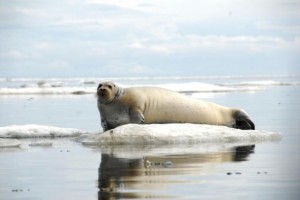
One of the warmest winters on record in Alaska means the spring season for bearded seals, or ugruk , has come nearly two months early for some hunters in Western Alaska. Warm weather makes the hunt a little easier, but locals are concerned about precarious sea ice and unpredictable weather.
The village of Wales sits out on a point, along the Bering Strait coast, midway between Kotzebue Sound and Norton Sound.
“We live right on the bottleneck of the Strait,” explained Clyde Oxereok. He’s a seal hunter in Wales. He says hunters there are already gearing up for their spring ugruk hunt, which usually doesn’t start until April.
“Some of the hunters there are saying we have to get ready now, because our leads are opening up and when they open up, we’re hungry for the fresh meat and the fresh oil and its coming earlier every year,” said Oxereok.
Ben Payana is also a seal hunter from Nome.
“I’m a King Island descendant,” he said. “My dad was born and raised for a little bit on King Island and he brought me up doing all the ocean hunting, marine mammal hunting and that’s what I do now, ever year.”
Payana explained the basics of hunting a seal.
“Right now, if I were to go seal hunting I would try to get up somewhere high and look out on the ice and try to find some leads, and then you’d go load up your snow machine and little row boat or whatever you’re going to retrieve the seals with,” he said. “[Then you] try to find your way to that lead and then hang out on the edge of the ice there until some seals swim by and then hopefully you’ll see one, shoot one and be able to retrieve it in time.”
Seal hunting can happen year round and there are many species. Hunters usually wait until April to hunt ugruk, but the weather has been unseasonably warm this February.
As Payana stood along the coast in downtown Nome, he looked out over the sea ice.
“I see a lot of jumbled up not very good ice for traveling,” he said.
Only a few days ago, steam rose from a large swath of open water, but a north wind blew big chunks of ice back up against the coast, so today, the bumpy, blocky edges peak out from windblown snow that seems to stretch for miles. Payana says there’s another problem with this ice.
“ … [It’s] not very thick ice out there for the seals to be denning in, because they should be having their pups in March and April too,” he said. “I’m not a seal, but I would imagine they would prefer some thicker ice and more snow cover so they can have a nice safe den for their pups.”
The story of this year’s sea ice up and down Alaska’s northwest coast is, well, jumbled.
“It’s a complicated picture,” said Becki Heim. She leads the Sea Ice Program for the National Weather Service in Alaska. There is no shorefast ice at Unalakleet to the south, or up in Kivalina to the north this year. Residents along the coast have posted photos and videos of thin ice and open water on social media sites all winter. Heim blames offshore winds.
“[The winds] have continued to blow the thickest ice that keeps refreezing out into the deeper waters offshore,” explained Heim. “What it’s doing is it’s leaving very thin new ice near shore, so that’s why there’s more leads and thinner ice and access to the water.”
Heim said it’s not rare for wind and sea ice to interact this way. But Clyde Oxereok said in recent years, not only is the ice less reliable but so is the weather.
“We can’t predict the weather,” he said. “We’re not going to 60 or 80 miles, even 30 or 40 miles anymore, which we used to do, because we knew the weather would hold. Now we can’t predict that anymore. So, that being said, we have to harvest what’s there when it’s there, when we have the opportunity to go and get it.”
Otherwise, said Oxereok, they could miss out on the ugruk harvest entirely.
Dennis Davis of Shishmaref has also seen the weather become more unreliable in the winter.
“When I was growing up with my grandpa in Kotzebue in the late 80s and early 90s, when they had dog teams and stuff like that,” said Davis, “You had to know how to read the weather or wonder what it’s going to do. Nowadays, it’s either hit or miss. You never know what’s going to happen.”
People like Davis understand that the Arctic is always changing. But what’s unclear is how best to adapt to the increasing uncertainty of what change means for the sea ice, the weather and a subsistence lifestyle.




